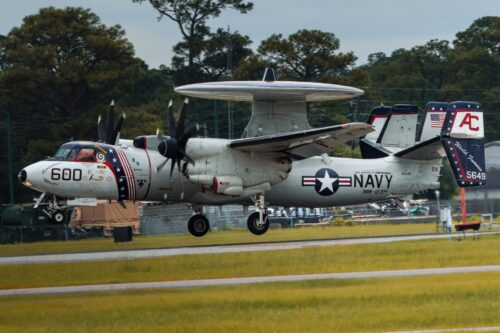The sun dipped low over the Arizona desert as two E-2C Hawkeyes, their wings casting long shadows across the tarmac, made its final approaches. The aircraft, belonging to Airborne Command & Control Squadron (VAW) 123, touched down gently at Davis-Monthan Air Force Base, the last of their kind to leave the squadron’s care. This event marks the end of an era for VAW-123 and the beginning of its full transition to the E-2D Advanced Hawkeye.

VAW-123 first received the E-2C Hawkeye in Nov. 1973. Since then, the squadron and the E-2C Hawkeye have participated in numerous deployments and operations around the world. From Operation Desert Shield/Desert Storm in the 1990s to Operations Enduring Freedom and Iraqi Freedom in the 2000s, and more recent operations in the Red Sea and the Gulf of Aden, the E-2C Hawkeye played a crucial role in projecting American power and ensuring maritime security.
The E-2C’s primary function was as an airborne early warning and control (AEW&C) aircraft. With its powerful radar and sophisticated communication systems, it provided a comprehensive picture of the battlespace, enabling the Navy to detect and track threats, manage airspace, and coordinate complex operations. The E-2C was also involved in search and rescue missions, drug interdiction, humanitarian efforts, and disaster relief.
Lt. Terrance Lawrence, a pilot assigned to VAW-123, who flew one of the E-2Cs to the boneyard, said, “It was something that I knew not a lot of other aviators get to do; it is pretty rare that you get to participate in this type of flight,”. He added, “This was a special and unique opportunity that does not come up often. I volunteered immediately.”
Lt. Avesta Shwany, who flew the second E-2C to the boneyard, reflected on the experience, “Getting to be a part of the last crew was incredibly bittersweet.” She explained, “This aircraft carries a lot of memories to so many aircrew members, especially from this most recent deployment to the Red Sea.” Shwany further noted the aircraft’s combat history and vital role in many missions. “Taking this aircraft to the boneyard signified the end of an era, and the beginning of our delta transition. I think everyone was surprised with how emotional we were dropping her off and saying our goodbyes.”
The transition to the E-2D Advanced Hawkeye brings with it a significant leap in capability. Featuring a new, state-of-the-art radar, upgraded aircraft systems, and an enhanced cockpit, the E-2D increases the Navy’s ability to operate in contested environments. Its extended range, increased persistence, and greater operational flexibility make it a more potent asset for the modern battlespace. VAW-123’s transition to the E-2D is expected to be completed by mid-2025. VAW-116, based on the west coast, is now the only fleet squadron still flying the E-2C.
For more information, hit the Source below
The photo that show an E-2C landing was taken at a different location, because the scenery at Davis Monthan Air Force Base looks a whole lot different, with it being located in the Arizona desert.